|

Installing a Transmission
Oil Cooler
Like most automatic
transmission equipped cars on the road today, the Mark
VIII uses a transmission oil cooler. This OEM cooler is
build into the motor's water radiator. It is designed to
keep the transmission oil as cool as the motor water
temperature. There is no excuse for injecting heat into
a cool transmission just because the motor is running
hot. Also, when racing or under high speed loads, the
transmissions in the Mark can use all the help it can
get to remove waste heat. The installation of a separate
transmission cooler, with the OEM cooler completely
bypassed, has always been a well discussed topic on the
Mark VIII forums.
Recently, Woodie and I have been swapping email about
cooler installation. Having thought out the process and
actually already doing it himself, Woodie supplied
pictures on the install as he did it. Following his
lead, I also installed a cooler. The location and the
mounting of the cooler is very well thought out. My
install went so well, that I though we should share it
with the rest of the members in the LOD club.
The following picture of
Woodie's installed cooler is a bug's eye view, just
prior to getting terminal headache number 999.

The Cooler: Scanning the discussion forums about
transmission coolers, one quickly can see that the
cooler to purchase is the "plate type" cooler and not
the "fin type." A plate cooler is build like a miniature
water radiator. The fin cooler is a long pipe with fins
attached to it. Sometimes the long pipe is folded into a
loop to reduce overall length and to keep the input and
output ports on one side of the cooler.
The cooler we both used were supplied by
www.carparts.com. It is a 24,000 GVW rated, plate
type unit, part number 70264. Once I received it, it
turned out to be a B&M "Super Cooler." It comes complete
with install hardware kit and decal (B&M Racing
Products.). I looked around at several local auto
stores, comparing pricing and quality of other coolers.
The closest I came to a match was a plate cooler from
O'Rielly that sold for 20 bucks more than what I did pay
at
www.carparts.com. The hardware kit supplied with the
cooler is designed to be installed in series with your
existing radiator cooler. That is, the output of one
cooler is routed to the input of the new cooler. Once
again, based on forum discussion with members, we
bypassed the OEM cooler and allowed the "Super Cooler"
to do it all.
Tools needed:
-
Standard blade screwdriver
or ¼ inch driver and sockets (for hose clamps.)
-
Drill motor and a
selection of metal drill bits (to make pilot holes
for mounting straps that hang the cooler.)
-
Mini pipe cutter (to cut
existing cooler plumbing.)
-
Sharp knife (to cut cooler
hose.)
-
Metal punch (to mark hole
to be drilled.)
-
Small screwdriver (to
extract plastic rivets.)
-
Standard Phillips head
screwdriver (to extract plastic rivets)
-
13mm tubing wrench (to
disconnect existing coolant plumping
-
A small plastic bowl or
container to catch tube fluid.
Supplies and Parts needed:
-
Plate type transmission
cooler, 24,000 pound GVW rating or above.
-
Three cooler mounting
straps (may be in hardware kit for cooler.)
-
Six ½ inch diameter hose
clamps (4 clamps may be in hardware kit for cooler.)
-
Three feet transmission
oil hose (may be in hardware kit for cooler.) Hose
MUST be rated for oil/fuel use.
-
Three sheet metal bolts
that fit mounting strap (may be in hardware kit for
cooler.) The self-drilling type makes the install go
faster and having to drill pilot holes is
eliminated.
-
Five nuts, bolts and lock
washers for mounting the cooler to the straps (four
sets of hardware may be in hardware kit for cooler.)
-
Teflon tape and bolts to
plug old radiator cooler lines (optional)
-
Hose coupling parts
(purchased at Home Depot for about 8 bucks. These
are Water cooler parts!)
2 ea. 1/8 inch pipe (male) to barbed hose connector.
2 ea. 1/8 inch pipe (female) to 1/8 inch pipe
(female) coupler.
2 ea. 1/8 inch pipe (male) to 3/16 inch ferrule
connector.
The Install:
-
The cooler is installed on
the passenger's of the hood latch, between the air
conditioner condenser and the bumper cover frame.
This location can be accessed from the top of the
engine compartment. To get to the location, you must
remove the plastic cover that hides this valuable
space.
a. The following two pictures show how to remove the
safety latch lever. The picture below shows Woodie
bending the metal "release" lever slightly to allow
him to remove the left end of the lever from where
it is fitted into a slot in the plastic cover.
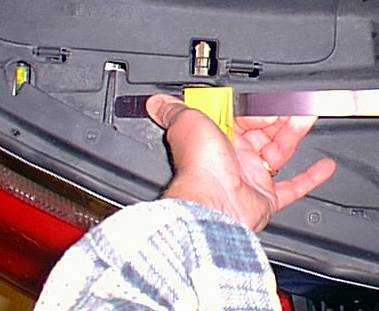
b. The next picture below shows how he rotated the
lever up to remove the other end from the slotted
release mechanism. Set this lever aside. Now attack
the plastic cover.
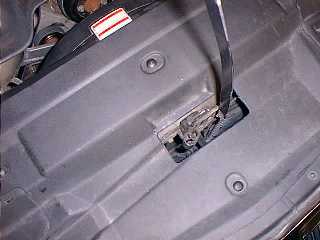
c. The cover is held with 5 plastic, screw expanded
rivets. A close up of the two handed method of
extracting the screw of one of these rivets is shown
below.
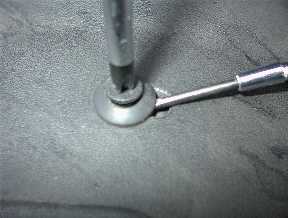
Notice the Phillips screw. If you're very, very
lucky, you can turn this screw and it will back out.
Once the screw is out, the plastic "rivet" is easily
removed from the hole. If you are not so lucky, like
99.99% of the time, you can turn the screw until you
puke and die and it will not budge an inch. The
secret to getting the screw out is sideways pressure
on the rivet bellows. Insert a small screwdriver
under the rivet head and press against the internal
body as shown in the picture above. You are pressing
in on the axis of the rivet. You are NOT trying to
pry up on the rivet The screwdriver blade will put
pressure on the screw body or on the plastic bellows
that the screw enters. Either way, the screw will
now creep upward as you turn it to extract it, so
long as you keep the pressure on the body. When the
head gets far enough up for you to grab it, you can
pull the screw out. After removing a few of the
rivets, you will be an expert. The following picture
shows a rivet removed and taken apart.
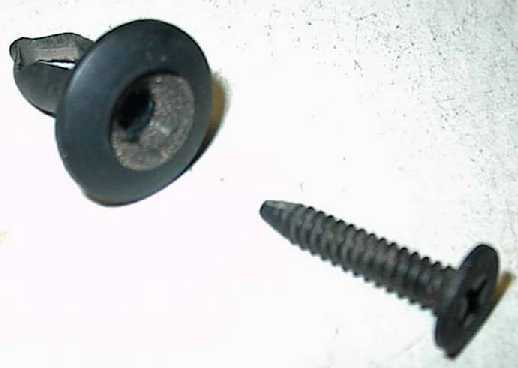
d. Once the five rivets are out, lift up on the
engine side of the plastic cover. It is fitted into
slots at the front edge. Put the cover aside.
-
The space exposed is the
space on the passenger's side, between the fender
and the hood latch. We will now mount the cooler
into this space.
a. Using two of the four straps included in the
cooler install kit, loosely attach a strap with two
bolts, lock washers and nuts in the pair of holes
that are four holes from the curved end of the strap
on each side of the cooler. The straps may need to
be attached on the backside of the cooler, depending
on how tight the fit is between the fender and the
hood latch. The space may be too tight for the
straps to hang perfectly straight down. They may
need to angle in toward the cooler. The straps have
no room to angle like this if you mount the straps
"inside" the cooler (between the cooler mounting
flange and the nipples.)
b. Position the cooler in the space exposed, keeping
the cooler oriented so that the cooler nipples are
pointed toward the center of the car. The top of the
straps will almost be even with the metal frame.
Mark or punch the location of the two hole locations
in the metal frame. Here is where you will see how
tight an installation you really have. We suggest
you mount the straps on the backside of the cooler.
c. Remove the cooler and tighten the four nuts
holding the upper strap on the cooler. Insure that
any angle the straps need to fit between the fender
and the hood latch stays on the straps after
tightening.
d. Drill two holes of the proper size in the frame
for the self -taping bolts supplied for mounting the
cooler. Be careful when drilling - there is a very
expensive air conditioner condenser on the other
side of that frame. Pushing your drill bit into that
condenser is not going to make your day. If you have
the self-taping, self-drilling metal screws that are
typically used for mounting sheet metal on bar stock
(for putting together metal buildings) you can use
them. Make sure they are not too long - protect that
condenser.
e. Temporarily slide the cooler down into its space
and loosely connect it to the frame using the two
self-taping bolts. We are now going to fit the
bottom strap to the cooler and bend it such that the
cooler stands more or less straight vertical. The
bottom strap will keep the cooler from swinging back
and forth as the car moves. We will be putting two
inside bends into the strap. One bend will be at the
bottom, just above the end of the strap mounting
hole. The other bend will be in the same direction,
but at the opposite end of the strap. This end
mounts the strap to the plastic fan bracket.
f. Remove the cooler from the car and mount the
lower strap to the INSIDE of the cooler mounting
flange, using one bolt, lock washer and nut. You're
going to have to supply this hardware, because you
have used up the mounting hardware they gave you in
the cooler install kit. Whether you use the lower
hole or the next hole up from the lower nipple on
the cooler mounting flange will depend on how much
of a bend you were forced to put into the strap. The
object of this mount is to have enough "meat" at the
fan shroud end to safely attach the strap to the
plastic surface.
g. Slide the cooler back into position. You may have
to use tongue English to get it to fit back in there
with three straps sticking up, but you can do it.
h. Woodie suggests to use the little adhesive-backed
rubber mounts that came in the kit to "pad" the
cooler straps. If you want to do likewise, tear off
a square pad, peel the tape from the sticky side and
press it against the strap (or the frame), centering
the pad's hole over the mounting hole in the strap
(or the frame). If you are sticking to the frame,
you might want to wipe the metal down to allow the
sticky to stick. Do both holes in like manner. Now
insert the bolts and bolt the straps down to the
frame. You may need to "pre-thread" the bolt into
the pad, if you stuck the pad to the strap, instead
of the frame.
i. Make sure the cooler is more or less parallel to
the condenser and mark the position of the hole for
the self-tapping bolt that will be connected here.
Or, if you have self-drilling bolts, position the
strap onto the plastic brace and drill/screw the
strap down.
j. You will end up with the cooler installed as
Woodie shows below.
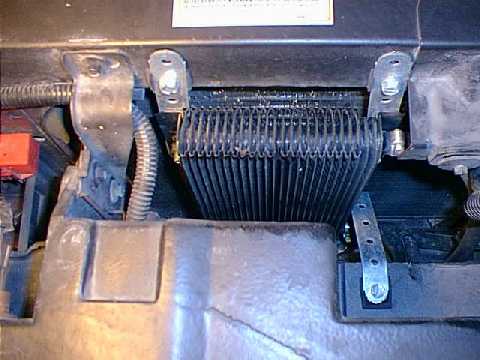
-
Plumbing the cooler to the
transmission.
a. Turn off the air ride switch and drive the car up
on wheel ramps or jack it up so that you can crawl
under it. If you use a jack, use jack stands.
b. The transmission is connected to the radiator
using two metal tubes. These tubes start at the
passenger's side of the transmission. They cross
under the front of the motor and end up on the
driver's side of the car. The tubes are connected to
the radiator on the left rear surface. The lower
tube is directly above the large water hose at the
bottom of the radiator. The upper tube is connected
to the same radiator surface a foot or two above the
lower tube. You will be cutting the tubes just
behind the first bend, on the passenger's side when
the tubes cross under the front of the motor.
c. Remove the ribbed plastic cover that is
protecting the tubes.
d. Remove the two clips that are holding the tubes
together.
e. Locate the rubber cooler hose that was supplied
with the install kit. And find the plastic bowl to
catch tube fluid.
f. Separate the tubes. Apply the mini-tube cutter to
each of the tubes and rotate until cut. A small
amount of fluid slipping past the cutter may make
this job messy. Position the plastic bowl to catch
leaks.
g. On a bench vise, preassemble the barbed hose
connectors, the coupling and the male part of the
ferrule connectors. Use Teflon tape on all male
threads. Once this assembly is complete, you will be
left with the ferrules and the compression nuts.
h. Slide the compression nut on to the end of the
tube.
i. Push on the ferrules, sliding it on the tube.
Allow about 1/4 inch of tubing to stick out of the
ferrule.
j. If you haven't done it already, apply Teflon tape
to the male threads of the pre-assembled compression
fitting.
k. Slide the compression nut and ferrule into the
compression fitting assembly and tighten the
compression nut.
l. Repeat steps h through k for the second hose
connection.
m. Install TWO hose clamps on one end of the UNCUT
hose and slip it on one of the barbed connectors.
n. Tighten the hose clamps.
o. Install TWO hose clamps on other end of the UNCUT
hose and slip it on remaining barbed connector.
p. Tighten the hose clamps. The complete assembly is
shown below.

q. Feed the loop of hose between the bumper cover
and the sheet metal above the cover. You may want to
install an old cut piece of radiator hose to act as
a bumper to soften the sharp edge of the sheet
metal. Such a bumper is shown below.
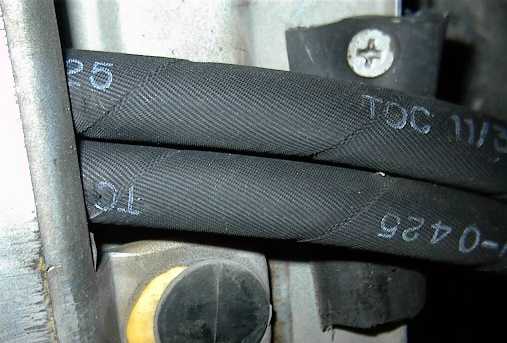
Notice the small sheet metal screw holding the old
hose in place under the tubing. I tied both hoses
together using tie-wraps. You may want to do this,
or re-use the two tubing clips.
r. Go back up to the top of the engine compartment
and position the hose loop to the lower cooler's
flared fitting. Cut the rubber hose loop so that the
bottom hose is just long enough to slide onto the
bottom cooler fitting.
s. Slide hose clamp over the hose and then slide the
hose onto the bottom fitting. Tighten this hose
clamp.
t. Move the hose to the upper cooler fitting. It
should be just long enough to fit. Slip on another
hose clamp at this end. Slide the hose on the upper
fitting and tighten the hose clamp.
-
Finishing up
a. The radiator cooler should have mostly drained by
now. Using a 13mm tubing wrench, disconnect the two
radiator tubes from the radiator. You may want to
use another wrench to counter-torque the fittings as
you remove the tubes.
b. Take the tubes to your work bench and cut each
fitting off, leaving about an inch and a half of
tubing sticking behind the fitting.
c. Using a bench vise, flatten the tube behind the
fitting about ½ inch from the end. Bend the
flattened tube 45 degrees or so. This will help plug
the tube. A prepared tube is shown below.
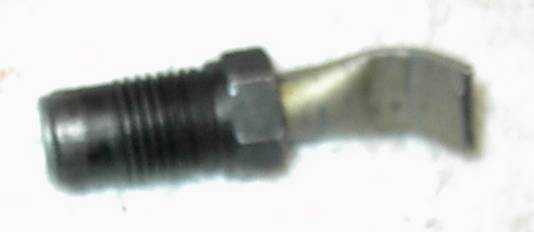
d. Reinstall the two plugged fittings to plug up the
old cooler holes.
e. Woodie used two metric bolts to act as plugs. You
may want to use Teflon tape on the bolts treads to
seal the connection.
f. Pour back in the transmission fluid you collected
in your tubing bowl.
g. Re-install the plastic cover and put the hood
latch lever back on.
h. Don't forget to check the fluid level after you
drive the car enough to warm the transmission up.
References:
1. Author's and Editor's personal experience with
their Mark VIII .
2. Question and replies on www.mark8.org and other
conference areas.
Submitted by:
Author: Jerry Heep (HOTLNC)
jjheep@hotmail.com
Technical Editor: Woodie Maples (MAPLES 8)
maples@htc.net
Edited 3/9/2004
by Jerry Heep

|










![]()









